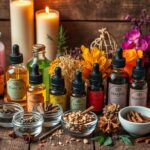Fragrance oils
Fragrance That Wows: A Beginner’s Guide to Adding Scents to Your Homemade Candles
Welcome to the world of candle making for beginners. Here, you’ll learn how to add fragrance to candles that excite your senses and brighten your home. Have you ever seen how expensive luxury candles can be? Often, they cost more than $50 for just 2.5 days of burning.
By making your own candles, you save money and can pick scents you love. This guide will cover the basics, from fragrance additives to essential and fragrance oils. You’ll learn how to make your space smell amazing!
Key Takeaways
- Luxury candles often cost upwards of $50.
- Homemade candles provide opportunities for customization and affordability.
- The ideal fragrance ratio is around 1 ounce of oil per pound of wax.
- Start pouring candles at temperatures between 120ºF and 140ºF.
- Waiting at least 24 hours before burning allows candles to cool properly.
- Consider eco-friendly options by using organic ingredients and sustainable packaging.
Introduction to Candle Making
Candle making is a fun hobby that combines creativity and relaxation. It lets you create your own unique DIY candles. These homemade candles make great gifts or can simply make your home feel cozier.
The first step is melting the wax. You can choose eco-friendly options like soy wax candles. AAK’s 464 soy wax is easy to work with, even for beginners. Start with a 1 lb (454 g) batch for your first try.
Heat the wax to about 185°F (85°C) for the best results. This temperature helps mix the wax with fragrance oils well.
When adding scent, use about 6% fragrance oil. This means 1 ounce (28 g) of fragrance for every 1 pound (454 g) of wax. This amount gives a nice smell without being too strong. Pour the wax into containers, like 8oz candle tins, leaving about 4 inches (10.2 cm) of space. Let the candles cure for at least two weeks for the best scent.
The Benefits of Homemade Candles
Making your own candles brings many benefits of homemade candles to your space and life. You can pick your scents and designs. Plus, you get to enjoy the art of natural candle making. Homemade candles are often cheaper than store-bought ones, saving you 20-50%.
Choosing eco-friendly candles is good for the planet. Soy or beeswax candles burn cleaner, improving your home’s air. Families making candles spend more time together, bonding by 30%.
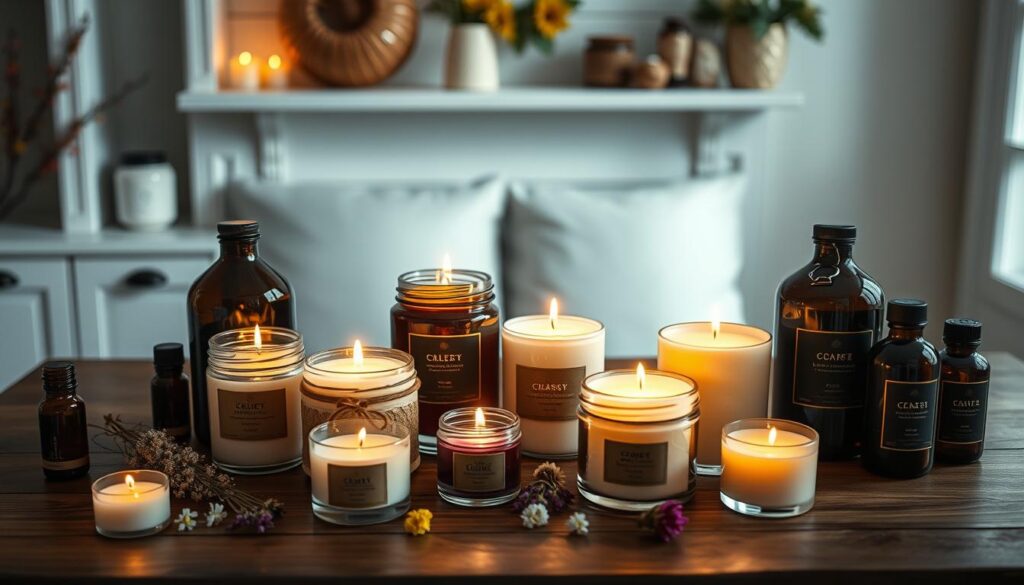
Candle making is a creative outlet that boosts mental health. Over 70% of makers feel more fulfilled. By making cost-effective candles, you can also give personalized gifts with special fragrances. This appeals to 60% of gift-givers during holidays.
The candle-making community is growing fast, with a 15% annual increase on social media. This shows a shift towards sustainable living, with 80% of makers using non-toxic ingredients. Homemade candles are a rewarding hobby that benefits you and the environment.
Choosing the Right Wax for Scented Candles
Choosing the right wax is key for scented candles. Each wax type has its own benefits and challenges. It’s important to know the differences between soy wax and beeswax for eco-friendly options.
Soy wax vs beeswax is a big debate for new candle makers. Soy wax is 100% natural and biodegradable, making up 25% of the market. It burns clean and holds scent well, making it great for eco-friendly candles.
Beeswax is about 10% of homemade candles and is known for quality and longevity. It has a natural honey scent and burns longer. Handling beeswax requires skill, but many love its unique qualities.
Paraffin wax is the most common, making up 70% of the market. However, it has a higher environmental impact. Palm wax is less common but appeals to those who want eco-friendly candles. Blended waxes offer customization in fragrance and burn time.
Learning about wax types is the first step in candle making. Each wax has its own features. Trying different waxes can lead to exciting discoveries in scented candles.
Essential Tools for Candle Making
Starting your candle-making journey means getting the right candle making tools. Knowing what candle making supplies you need makes the process easier. Here are the key items for your toolkit:
- Candle wax (paraffin, soy, or beeswax)
- Containers or molds (metal, plastic, or silicone)
- Candle wicks
- Thermometer
- Double boiler or heat-safe pitcher
- Stirring tool
- Chopsticks
- Wick trimmer or scissors
A good thermometer is key for checking wax temperatures. This helps you know when to add scents and pour the wax. A double boiler setup is safe for melting wax, avoiding burns from direct heat. When buying DIY candle supplies, look for a quality thermometer that works with candle wax.
Each type of candle wax has its own benefits. Paraffin wax has a great scent throw and burns slowly. Soy wax melts low and works well with fragrance oils. Beeswax is eco-friendly, burns long, and smells natural. Choosing the right wicks is also important. Wooden and cotton wicks are popular, but make sure they fit your containers.
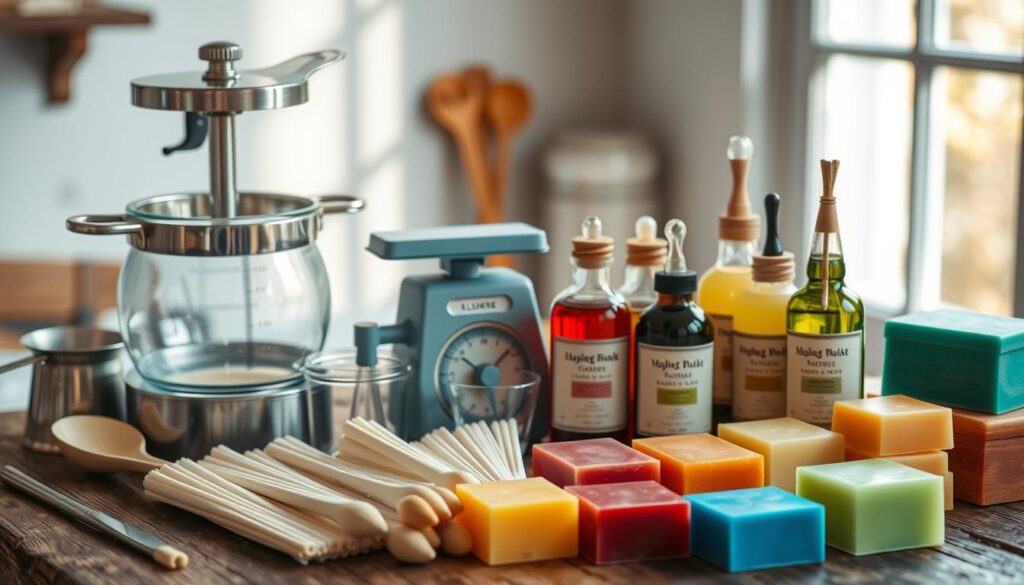
When you’re ready to make candles, keep wick lengths between 14 to 18 inches. This reduces soot and improves fragrance. Using wick holders keeps your wicks straight while they cool. Getting the right equipment for candles is crucial for making beautiful, fragrant candles.
Choosing Fragrance: Essential Oils vs. Fragrance Oils
Starting your candle-making journey means deciding between essential oils and fragrance oils. Each has its own benefits, letting you craft candles with unique scents. Knowing about scent strength and longevity helps you pick the right one for your vision.
Understanding Scent Strength and Longevity
Fragrance oils give a stronger smell than essential oils. Essential oils come from plants and have softer, often healing scents. Fragrance oils, on the other hand, offer a wide range of strong smells. This affects both the scent strength and scent longevity in your candles.
Here’s a quick comparison of essential and fragrance oils:
| Aspect | Essential Oils | Fragrance Oils |
|---|---|---|
| Aroma Intensity | Less intense, natural scents | More potent, synthetic or mixed scents |
| Scent Longevity | Up to 12 months | 1-2 years (sometimes longer) |
| Cost | Generally higher due to extraction | Typically cheaper, mass-produced |
| Environmental Impact | Resource-intensive extraction process | Varies; some may use petroleum |
| Therapeutic Benefits | Known for aromatherapy effects | Primarily focused on fragrance |
Choosing the right ingredient affects the scent’s strength and how long it lasts. If you want scents that last, fragrance oils are a good choice. Try different options to make your candle-making even better!
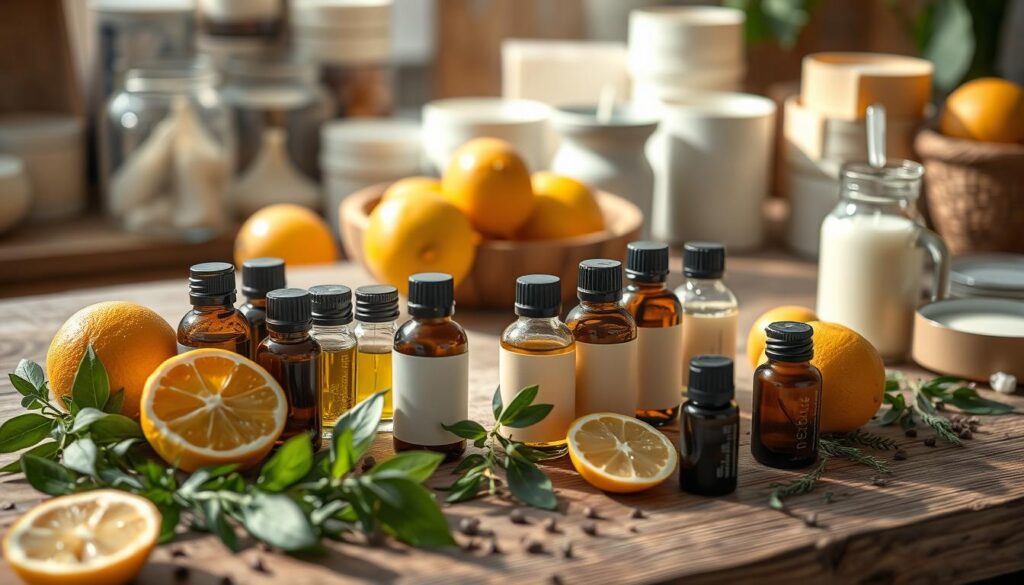
How to Add Fragrance to Candles?
Learning to add fragrance to soy candles is fun and rewarding. It’s all about finding the right fragrance ratios and avoiding mistakes. Here are some key tips to get a great scent in your candles.
Recommended Ratios for Fragrance Additives
Getting the fragrance right is key for great candles. For a 16-ounce Mason jar, start with 10-20 drops of essential oil. Here’s a simple guide for ingredient amounts:
| Wax Weight (grams) | Fragrance Oil Weight (grams) | Fragrance Load Percentage |
|---|---|---|
| 147.2g | 12.8g | 8% |
Experiment with different essential oils for unique scents. For example, mix six drops of eucalyptus with six drops of lavender for a fresh, calming smell. Make sure to use double the wax flakes as the final volume. Let candles set for hours or overnight before lighting.
Common Mistakes to Avoid
When making candles, avoid some common mistakes. Here are a few tips:
- Don’t add fragrance to hot wax. It can make the scent disappear.
- Choose the right wax for your fragrance. The wrong wax can affect the scent.
- Trim the wick to about ¼ inch before lighting for the best burn.
- Give soy wax candles at least one week to cure for the best scent.
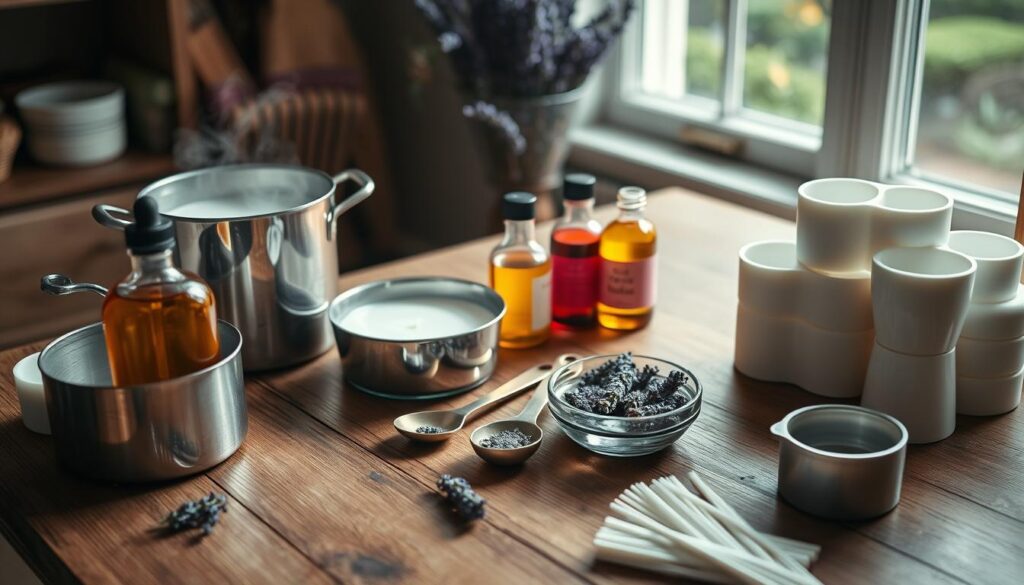
Follow these tips to master adding fragrance to soy candles. Getting the scent right takes time and practice. But by avoiding these mistakes, you’ll be well on your way to making great candles.
Step-by-Step Guide to Adding Fragrance to Your Candles
Making a scented candle is all about preparation and detail. This guide will show you how to set up your workspace and melt wax for candles.
Preparing Your Workspace
Having a clean and organized workspace is key. Here’s how to get started:
- Clear your space of clutter and arrange your tools.
- Collect wax, fragrance oils, pitchers, and wicks.
- Make sure your area is well-ventilated to avoid strong smells.
- Wear gloves and protective eyewear for safety.
Measuring and Melting Wax
Measuring and melting wax correctly is important for scent. Start by measuring your wax for the size of your containers. For example, use 6% to 8% fragrance in All Seasons Wax. This means about 27.3 ml or grams of fragrance for a 390 ml jar at 7% load.
Use a double boiler to melt wax at the right temperature. The ideal temperature is 130-140°F (50-55°C). Add fragrance oils to melted wax right away for best mixing and scent.
Let your melted mix cool a bit before pouring it into molds. Keep the pouring temperature around 140°F (60°C). This step is crucial for a smooth finish and to prevent sweating in soy content candles.
Tips for Enhancing Scent Throw in Candles
Creating candles that fill your space with delightful aromas involves understanding how to make candles smell stronger. Curing time is key in enhancing candle aromas. By following best practices for candle curing, you ensure your candles perform at their best.
Best Practices for Curing Candles
The curing process allows the wax and fragrance oil to bond effectively. This leads to a more potent fragrance when burned. Here are some key points on how to achieve optimal results:
- Allow candles to cure for at least 1-2 weeks for soy and other natural waxes to maximize scent throw.
- If using paraffin wax, aim for 3-5 days of curing time.
- Smaller candles may only require a minimum of 1 day depending on supplier recommendations.
- Maintain a consistent environment, as factors like temperature and humidity may influence fragrance release.
- Ensure proper wick size and placement, as this affects how evenly the wax melts and thus how well scents are released.
Incorporating these tips will guide you toward enhancing candle aromas effectively. Focus on the right blend of wax and fragrance, alongside optimal curing times, to create an inviting ambiance in your space.
Troubleshooting Candle Fragrance Issues
Making candles is a fun hobby, but sometimes you hit troubleshooting candle fragrance problems. Issues like weak scent throws can be a letdown. Knowing these problems helps you find weak scent throw solutions and improve your skills. Here are some key points to consider for better candle scent performance.
Weak Scent Throw Solutions
Weak scent throw is a common problem for candle makers. It’s caused by several factors:
- Low fragrance oil dosages: Make sure you’re using the right amount of fragrance oil. A good rule of thumb is 6-10% of the total wax weight.
- Wick sizing: The wrong wick size can stop your candle from melting the wax right. A too-small wick can cause tunneling, making scent dispersal hard.
- Curing time: Give your candles time to cure, usually 1-2 weeks. This lets the fragrance bind and reach its full strength.
- Slow cooling processes: When using soy wax, cool it slowly in the pour pot. This prevents frosting and bumpy tops, which can hurt scent throw.
Try different wick types and sizes. Make sure the wick is at least ¼ inch above the wax for best burning.
| Wax Type | Common Issues | Fragrance Load |
|---|---|---|
| Paraffin | Produces soot, less natural | Up to 10% |
| Soy | Frosting, bumpy tops | Up to 10% |
| Beeswax | Expensive, but burns clean | 5-8% |
| Coconut | Expensive, excellent scent throw | 6-10% |
With careful attention and some trial and error, you can solve these problems. Improving your candle scent performance makes your candles more fragrant and enjoyable.
Conclusion
DIY candle making is a fun way to show your creativity and enjoy your senses. It lets you make candles that smell great and match your style. This article has helped you learn how to make candles that smell wonderful.
Remember, use 7% to 10% fragrance in your candles for the best smell. Let your candles sit for at least 48 hours before using them. This helps them smell even better.
Creating candles is a mix of art and science. It lets you make your own special scents. Try different essential oils to find your favorite smells. Enjoy the process and make your own scented candles today!
FAQ
How do I add fragrance to my homemade candles?
To add fragrance, first measure your wax. Use 6-10% of the wax’s total weight for essential oils. For fragrance oils, use a bit more. Melt the wax to the right temperature, then mix in the fragrance well before pouring.
What are the best essential oils for candle making?
Popular essential oils for candles include lavender, eucalyptus, lemon, and peppermint. They smell great and have calming effects, making your candles more enjoyable.
How can I make my candles smell stronger?
To strengthen the scent, increase the fragrance load in your recipe. Use the right wax and let the candles cure for 24 hours after pouring. This helps the wax bind with the fragrance.
What is the difference between fragrance oils and essential oils for candles?
Essential oils are natural and come from plants, offering subtle scents. Fragrance oils are synthetic and have a wider range of scents. They provide stronger and longer-lasting smells for candles.
How do I calculate the fragrance load for my candles?
To find the fragrance load, know the wax’s total weight and multiply by the desired percentage (usually 6-10% for essential oils). For example, with 1 pound (16 ounces) of wax and a 10% load, add 1.6 ounces of fragrance oil.
What tips do you have for adding fragrance to homemade candles?
For adding fragrance, measure carefully and avoid adding scent to hot wax. Test different wick sizes and let the candles cure well to improve the scent.
Why does my candle have a weak scent throw?
A weak scent throw might be due to low fragrance oil, wrong wick size, or not curing the candle long enough. Try different variables to boost the scent.
What is the best temperature to add fragrance to candle wax?
The best temperature for adding fragrance oils is 130-140°F. This ensures the scent infuses well without evaporating.
How do I troubleshoot candle fragrance problems?
For fragrance issues, check the fragrance load, wax temperature, and wick size. Try different types and ratios to find what works best.
What are some effective candle scenting techniques?
Effective techniques include layering scents, blending oils, and trying different wax types. See how they affect the fragrance release.
best essential oils for candles
Imagine coming home after a long day, looking for comfort. You light a candle, and your space changes instantly. The scent takes you to a peaceful place, easing your stress.
This magic comes from the quality of the essential oils. Choosing the right ones can make your evening special. These natural scents not only smell amazing but also make your home healthier and calmer. Let’s explore the world of essential oils, where each drop can enhance your home’s ambiance.
Key Takeaways:
- French Lavender Essential Oil offers strong cold and hot throws with no discoloration.
- Patchouli Essential Oil provides robust cold throws but may cause wax discoloration.
- Essential oils are costlier but provide natural, single-noted fragrances.
- Essential oils like lavender and tea tree are popular choices for homemade candles.
- Wax can absorb up to 10% of fragrance; avoid exceeding this for optimal scent throw.
Introduction to Essential Oils for Candle Making
Essential oils are concentrated plant extracts. They are made through distillation. These oils add more than just a nice smell to candles. They also affect your mood and health.
Using the top essential oils for candle making blends old skills with the healing power of plants. This makes candles not just for light but for wellness too.
In the UK, over a quarter of homes buy scented candles. This makes the market worth £90 million. This shows how popular essential oils for candle fragrance have become. These oils can be very strong, with up to 15 ml of pure extract in one.
Essential oils in candles are not just a new trend. They have been used for over 5000 years. Unlike fake fragrances, essential oils have real healing powers. They can help your body and mind feel better.
The Rose Tree is a great example of candle making. They use 100% vegetable wax and pure essential oils. Their candles burn for up to 35 hours, making them a good choice for those who love aromatherapy.
If you want to make candles, learning about essential oils for candle fragrance is key. First, pick wax that melts and pours well. Here’s some info to help you choose:
| Wax Type | Melting Point | Pour Temperature |
|---|---|---|
| Bayberry Wax | 112°F-128°F | 120°F-130°F |
| Coconut Wax | 120°F-130°F | 150°F-190°F |
| EcoSoya™ CB-135 | 117°F | 100°F-130°F |
| EcoSoya™ CB-Advanced Soy Container | 115°F | 100°F-155°F |
| Palm Wax (CrystalPillar Blend) | 143°F | 200°F-210°F |
| Vegetable Wax (Containers) | 126°F | 175°F-185°F |
| Pillar Vegetable Wax | 143°F | 175°F-185°F |
Choosing top essential oils for candle making means your candles do more than just light up a room. They can also make you feel better.
Benefits of Using Essential Oils in Candles
Using essential oils in candles is more than just a nice smell. It’s about wellness and caring for our planet. It can make you feel better and help the environment in many ways.
Health Benefits
Essential oils in candles do more than smell good. They can really help your health. For example, lavender oil can calm you down and help you sleep better.
Other oils like patchouli and ylang-ylang can make you feel happier. They create a peaceful space that’s good for your mind and body.
Environmental Benefits
Choosing essential oils over synthetic fragrances is better for the planet. Essential oils are natural and don’t have harmful chemicals. This means they don’t release bad stuff into the air.
Beeswax candles with these oils also clean the air. Plus, these oils last a long time, which is good for your wallet and the planet. It’s a win-win for a greener lifestyle.
Factors to Consider When Choosing Essential Oils
When picking the best essential oils for homemade candles, think about a few important things. These factors affect how well and safely your candles work. They also change how you enjoy making candles. Look at both the cost and the flash points when choosing.
Cost
Natural essential oils are often pricier than synthetic scents because they need a lot of plant material. If you want to make candles that don’t break the bank, think about mixing essential oils. Many crafters mix them to save money without losing the natural benefits.
Flash Points
The flash point of an oil is key because it shows how it acts with heat. Oils with higher flash points are safer and work better for candles. For example, lavender and patchouli oils have high flash points. This makes them safe choices for your homemade candles.
Here are some tips to pick the best essential oils for homemade candles:
| Essential Oil | Average Cost (per oz) | Flash Point (°F) |
|---|---|---|
| Lavender | $10.00 | 156 |
| Patchouli | $12.00 | 200 |
| Lemon | $7.00 | 118 |
| Mint | $9.00 | 185 |
Best Essential Oils for Candles
Finding the best essential oils for candles can make your candle-making better. It can change your home’s feel. We’ll look at four top essential oils for great scents and health benefits.
Lavender Essential Oil
Lavender essential oil is known for its calming effects. It’s a favorite for candle makers. It has a strong scent both when cold and hot, and it doesn’t change the wax color.
French Lavender is especially good for candles. It creates a peaceful space.
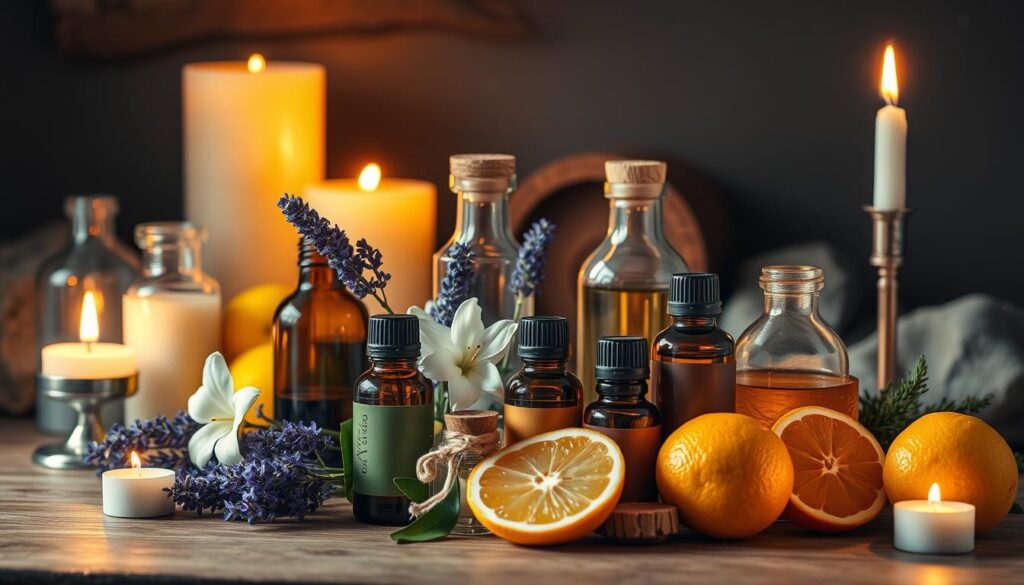
Patchouli Essential Oil
Patchouli essential oil adds a deep, earthy smell to candles. It has a strong scent when cold but a bit weaker when hot. It might turn the wax yellow, but its calming effects are worth it.
Ylang Ylang Essential Oil
Ylang Ylang essential oil has a sweet, floral scent. It’s great for making spaces feel romantic and for easing stress. It has a strong scent both cold and hot, with little wax color change.
The scent might change a bit when it’s burning. This adds depth to your candle’s smell.
Cedarwood Essential Oil
Cedarwood essential oil has a rich, woody smell. It’s perfect for spaces where you want to focus and relax. It has a strong scent both cold and hot, with little wax color change.
This makes it a top choice for candles. It’s great for creating a calm and focused space.
Popular Essential Oil Blends for Candles
Creating the perfect candle fragrance is fun with popular essential oils. It can make your home smell amazing and feel welcoming.
- Lavender and Cedarwood: This mix is great for a calm and cozy space. Lavender’s soothing scent works well with cedarwood’s warmth.
- Ylang Ylang and Patchouli: Ylang ylang relaxes you, while patchouli adds a deep earthy smell. Both oils have strong scents, making your home feel peaceful.
- Frankincense and Sweet Orange: This blend is uplifting and refreshing. It combines frankincense’s rich scent with sweet orange’s zest, perfect for mental clarity.
- Peppermint and Eucalyptus: This mix boosts focus and energy. It also helps with breathing. Peppermint lifts your mood, and eucalyptus fights colds.
- Lemon and Lemongrass: This blend is fresh and calming. Lemon improves focus, and lemongrass reduces stress. It’s both refreshing and soothing.
To make these blends for a 4-ounce candle, you need to know the fragrance load. For an 8-ounce candle, use ½ an ounce of essential oils, or 300 drops. Adjust the amounts as needed:
| Blend | Essential Oils (drops) |
|---|---|
| Lavender & Cedarwood | 75 Lavender, 75 Cedarwood |
| Ylang Ylang & Patchouli | 75 Ylang Ylang, 75 Patchouli |
| Frankincense & Sweet Orange | 75 Frankincense, 75 Sweet Orange |
| Peppermint & Eucalyptus | 75 Peppermint, 75 Eucalyptus |
| Lemon & Lemongrass | 75 Lemon, 75 Lemongrass |
Try these blends to find your favorite scents. They can make your candles perfect for any moment. These essential oils will fill your home with magical smells.
Considerations for Using Essential Oils in Soy Candles
Creating homemade soy candles can be rewarding if you know how essential oils work with soy wax. Choosing and testing essential oils carefully is key to a great experience.
Compatibility of Soy Wax
Soy wax is perfect for essential oils, burning clean and spreading scents well. It’s important to pick the best essential oils for homemade candles for better smell and performance. Soy wax also burns longer, releasing scents steadily.
Testing and Performance
Testing essential oils in soy candles is crucial. We tested five oils: French Lavender, Patchouli, Egyptian Geranium, Organic Ylang Ylang, and Cedar. We looked at how they smelled and if they changed the wax color.
Our tests used Virgin Coconut Soy™ Candle Wax and 10% essential oil. This gave us important insights.
Here’s what we found about these oils’ performance and color impact:
| Essential Oil | Scent Strength | Wax Color Change |
|---|---|---|
| French Lavender | Strong | Minimal |
| Patchouli | Moderate | None |
| Egyptian Geranium | Moderate | Minor |
| Organic Ylang Ylang | Strong | Noticeable |
| Cedarwood | Strong | Minimal |
Using essential oils with higher flash points is cost-effective. They vaporize less, staying stable when heated. Be careful with oils that flash below 170°F to avoid safety risks. Blending oils can make scents more complex but is pricier than using fragrance oils.
The Drawbacks of Using Certain Essential Oils in Candles
Essential oils for candle fragrance bring natural scents and health perks. Yet, they come with some downsides. For one, they can be very expensive. High-quality oils like rose or sandalwood cost a lot because it takes a lot of plant material to make them.
For example, it takes about 10,000 pounds of roses to get just one pound of rose oil. This makes a small 5ml jar of rose essential oil cost around $200-$250.
Another issue is the safety risks from essential oils with low flash points. Flash points are the temperatures at which oils can catch fire. This is a fire hazard when using these oils in candles.
Not all essential oils can handle the heat of candle burning well. This can reduce their scent and health benefits.
Essential oils might not give as rich or lasting scents as synthetic or natural fragrance oils. Fragrance oils, made in labs, are designed to last longer in candles. They can last 1-2 years, while essential oils last up to 12 months.
Fragrance oils also include chemicals like Diethyl Phthalate (DEP) to keep the scent strong and stable.
Here’s a comparative look at essential oils and fragrance oils:
| Aspect | Essential Oils | Fragrance Oils |
|---|---|---|
| Scent Longevity | Up to 12 months | 1-2 years |
| Cost | High (e.g., $200-$250 for 5ml Rose Oil) | Lower |
| Source | Natural plant extracts | Laboratory-made (including natural materials) |
| Safety | May have low flash points, potential fire hazard | Governed by RIFM and IFRA |
| Environmental Impact | Resource-intensive extraction process | More sustainable options available |
If you face these drawbacks, think about using natural fragrance oils for candles. These oils offer complex scents and last longer without the high costs and safety risks. Fragrance oils with essential oils are also a good choice. They are often phthalate-free and made specifically for candles.
My Favorite Essential Oil Candle Combinations
Choosing the right essential oil candle combinations can make your home smell amazing. Most people buy candles for their scent and to relax. Here are some top picks that use the best essential oils for candle scents, perfect for any time of year.
Floral and Herb Combinations
Floral and herb scents are great for a fresh, clean smell. A favorite mix is French Lavender and Egyptian Geranium. They create a calming scent, perfect for spring and summer.
French Lavender has a strong smell but doesn’t change the color of the wax. Egyptian Geranium also has a strong scent and keeps the wax color the same.
“These floral and herb combinations are not only pleasing to the senses but also support your health by promoting relaxation, enhancing mood, and improving sleep quality.”
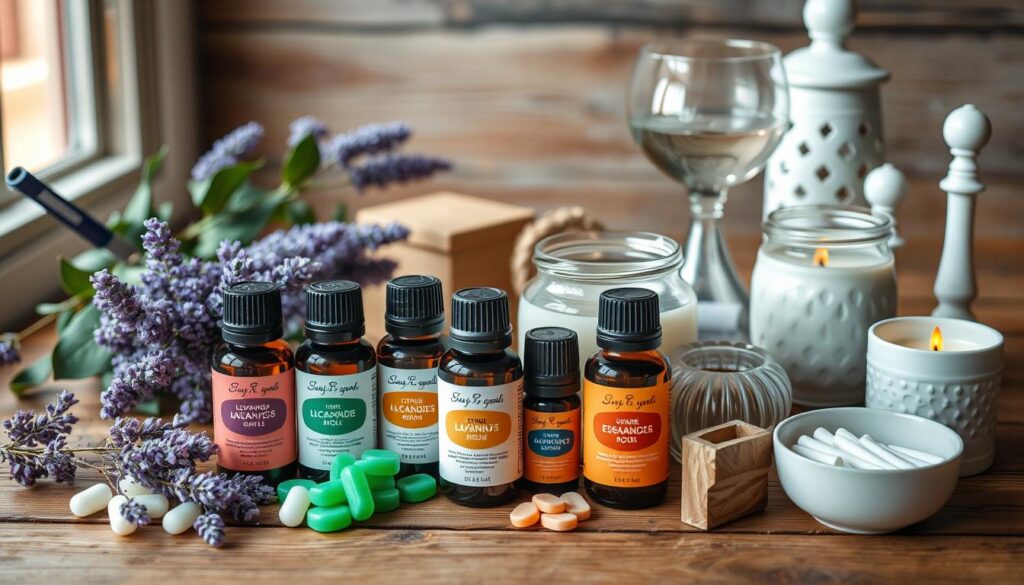
| Essential Oil | Cold Throw | Hot Throw | Discoloration | Approval Status |
|---|---|---|---|---|
| French Lavender | Very strong | Very strong | None | APPROVED |
| Egyptian Geranium | Strong | Strong | None | APPROVED |
Woody and Spicy Combinations
Woody and spicy scents are perfect for a cozy winter night. Try mixing Cedarwood and Cinnamon for a warm scent. Cedarwood has a strong smell and only a little color change, keeping the scent going.
Cinnamon adds a spicy touch, making the blend warm and inviting. It’s great for cold weather.
Using these premium essential oils for candle scents evokes feelings of warmth, security, and relaxation, especially when paired with the inviting crackle of a wooden wick.
Conclusion
Exploring the best essential oils for candles has been a journey of discovery. You’ve learned how to make your space more inviting and improve your mood. Essential oils like Lavender, Patchouli, and Ylang Ylang let you customize your candles.
Essential oils do more than just smell good. They help you relax, feel happier, and even sleep better. Choosing plant-based oils makes your candles better for the planet. Storing them right keeps their scent strong.
Candle-making is all about trying new things. You can mix different scents to create unique fragrances. By following the right steps, like using the right wax and essential oils, you make candles that smell amazing. Enjoy making candles that are just right for you.
FAQ
What are the best essential oils for candles?
Lavender, patchouli, ylang ylang, and cedarwood are top picks for candles. They’re known for quality, benefits, and scent.
What are the health benefits of using essential oils in candles?
Essential oils can boost mood, reduce stress, and help you sleep better. Lavender oil, for example, is calming.
Are natural essential oils for candles better than synthetic fragrances?
Yes, natural oils are better. They clean the air, don’t release harmful VOCs, and support a green lifestyle.
Why is the flash point important when choosing essential oils for candles?
The flash point shows if an oil is safe and works well in candles. Oils like lavender and patchouli are safer and less likely to cause fires.
Can I use essential oils in soy candles?
Absolutely. Soy wax is great with essential oils. It burns clean and spreads the fragrance well.
What are some popular essential oil blends for candles?
Favorites include lavender and cedarwood for calm, or ylang ylang and patchouli for romance.
What are the cost considerations when using natural essential oils?
Natural oils can be pricier because they need more plant material. To save money, blend oils or use them carefully.
How do I test the performance of essential oils in soy candles?
Test them to see how well they smell and if they change the wax color. Lavender and patchouli work well in soy wax.
What are some favorite essential oil candle combinations?
Try lavender and rosemary for a fresh scent, or cedarwood and cinnamon for warmth.
What are the drawbacks of using certain essential oils in candles?
Some oils are pricey, might be risky if they have low flash points, and can be simple in scent. Natural fragrance oils can offer more complex smells.
- Fragrance That Wows: A Beginner’s Guide to Adding Scents to Your Homemade Candles
- best essential oils for candles
- wood wick guide
- how to make candles smell stronger
- how to ship candles
- how to fix soy wax frosting
- wick Guide how to choose the right wick size with chart
- how to make candle molds
- how to clean candle wax
- how to reuse candle jars
- soy wax candle troubleshooting
- best wax melter for candle making
- how to conduct burn test
- why candle flickering crackling smoking
- how much wax per candle
- how to make candles smell stronger
- Easy Ways to Increase the Scent Throw of Your DIY Candles
- How to Make Candles for Meditation and Relaxation
- Using Upcycled Materials in Candle Making
- How to Make Hand-Poured Candles: Tips and Techniques
